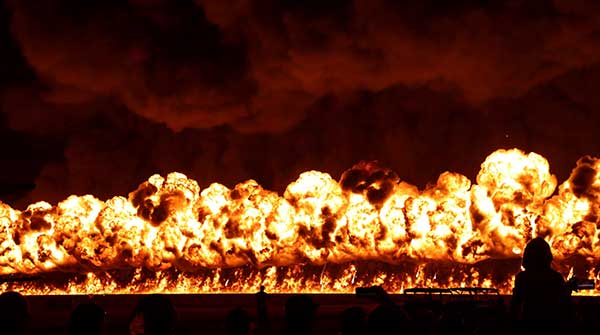Don’t start a war in the first place. Too bad Hamas couldn’t figure that out, or simply didn’t care
 Union Major General William T. Sherman, commanding officer of Union troops in the vicinity of Atlanta, Georgia, in early September 1864, had just routed Confederate forces in a bloody campaign to capture the city and now warned the citizens of Atlanta to evacuate.
Union Major General William T. Sherman, commanding officer of Union troops in the vicinity of Atlanta, Georgia, in early September 1864, had just routed Confederate forces in a bloody campaign to capture the city and now warned the citizens of Atlanta to evacuate.
His plan was to burn it.
Sherman had no intention of perpetrating a mass slaughter, but he did aim to level the city. Some leading citizens of Atlanta wrote to beseech him to spare Atlanta.
On Sept. 12, 1864, he answered the citizens in a two-page letter, declaring: “You cannot qualify war in harsher terms than I will. War is cruelty, and you cannot refine it; and those who brought war into our Country deserve all the curses and maledictions a people can pour out. I know I had no hand in making this war, and I know I will make more sacrifices today than any of you to Secure Peace. But you cannot have Peace and a Division of our Country.”
Sherman did not aim to kill Southerners, not in Atlanta nor in his subsequent “march to the sea.” But the core of his argument applies almost perfectly to the phenomenon that came to dominate warfare in the 20th and 21st centuries – aerial bombing.
Early advocates of air power – Hugh Trenchard of the UK and Giulio Douhet of Italy – believed that the chief target of any bombing campaign had to be the morale of the enemy population. They believed that “morale bombing” – later called area bombing and, to some, “carpet bombing”, would so undermine a population’s will to fight that victory would soon follow.
Their followers in Italy, Japan, Germany, and the United Kingdom practiced the deadly trade in the wars of the 20th and 21st centuries. The Japanese inflicted it on China. Italy inflicted it on Ethiopia, and Germany inflicted it on Warsaw, Rotterdam, London and other British cities. This was deliberate aerial murder, and it inevitably produced its counterstroke when the Allies resorted to the same tactics in bombing Germany and Japan in the Second World War.
The Royal and Royal Canadian Air Forces killed some 70,000 German civilians in Hamburg in 1943 and Dresden in 1945. They studied and carried out bombing tactics that produced firestorms. The Americans – using the same tactics – killed some 100,000 people in Tokyo in early March 1945. They did the same to almost every other Japanese city, ending with the nuclear attacks on Hiroshima and Nagasaki.
These attacks prompted Churchill to proclaim in 1943 after seeing film of German cities being bombed: “Are we beasts?”. But of course, he himself was an architect of these bombing campaigns.
From the early 1950s, after the 1946 publication of Hiroshima by American writer John Hersey – a book that followed the story of some of the victims of the atomic bombing – public opinion began to change in the West toward efforts to avoid mass civilian casualties in bombing campaigns. In Korea (1950-1953) and Vietnam (1965-1975), the U.S. sought to avoid mass slaughter of civilians (despite Communist propaganda to the contrary), although tens of thousands of civilians were killed anyway – collateral damage. That was also true in Libya, Iraq, and Afghanistan. In these cases, Sherman’s warning came true – it is war, and war is horrible and can only be described in harsh terms.
Any country that attempted strategic bombing of purely military targets in this century – including the U.S., the UK, Canada, and Israel – killed “innocent” civilians. There is no getting around it.
When the Royal Canadian Air Force joined the campaign to bomb Serbia and Serbian troops in the Kosovo air war of 1999, representatives of the Judge Advocate General – the chief law enforcement officer of the Canadian Armed Forces – sat at the targeting briefing before Canadian jets went into action to pronounce on the “legality” of each and every target the RCAF intended to hit. Innocent people died anyway. We have precision-guided munitions (PGMs) today, guided by lasers or GPS signals, but innocent people still get killed. There is no bomb invented which can distinguish between a Hamas terrorist and a civilian medical worker.
These considerations don’t apply to dictatorships. No one knows – or will ever know – how many Syrians were deliberately murdered by Russian bombers in the early days of the Syrian civil war to dislodge Hafez al Assad from the presidency of Syria. If Hamas had had a real air force, there is no telling how many Israeli civilians would have been killed on Oct. 7 in addition to the 1,200 who did die.
About half of the bombs that the Israeli Air Force is using in Gaza are “dumb” bombs, gravity bombs that, once released, are subject to air pressure, humidity, and winds on their way to the target. They cannot self-adjust as do precision-guided munitions. PGMs were first used in large numbers in the closing years of the Vietnam War, but they are still very expensive when compared to “dumb” bombs, which are still widely used by most air forces. Dumb bombs will kill more innocent civilians than PGMs, but both cause wide collateral damage.
There is really only one way to avoid civilian casualties by aerial bombardment – don’t start a war in the first place. Either Hamas could not figure that out, or they didn’t care.
David Bercuson is a Senior Fellow at the Aristotle Foundation and Director Emeritus of the Centre for Military, Security and Strategic Studies at the University of Calgary.
For interview requests, click here.
The opinions expressed by our columnists and contributors are theirs alone and do not inherently or expressly reflect the views of our publication.
© Troy Media
Troy Media is an editorial content provider to media outlets and its own hosted community news outlets across Canada.


